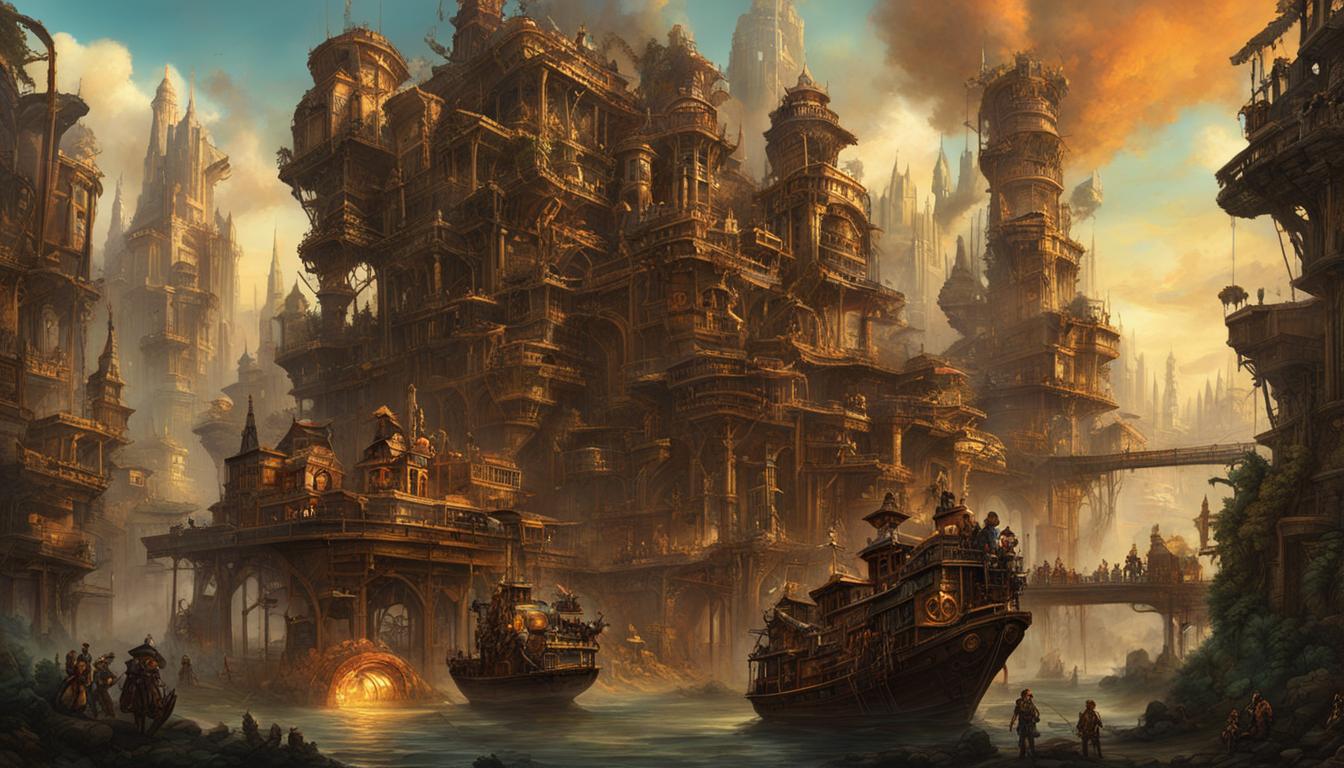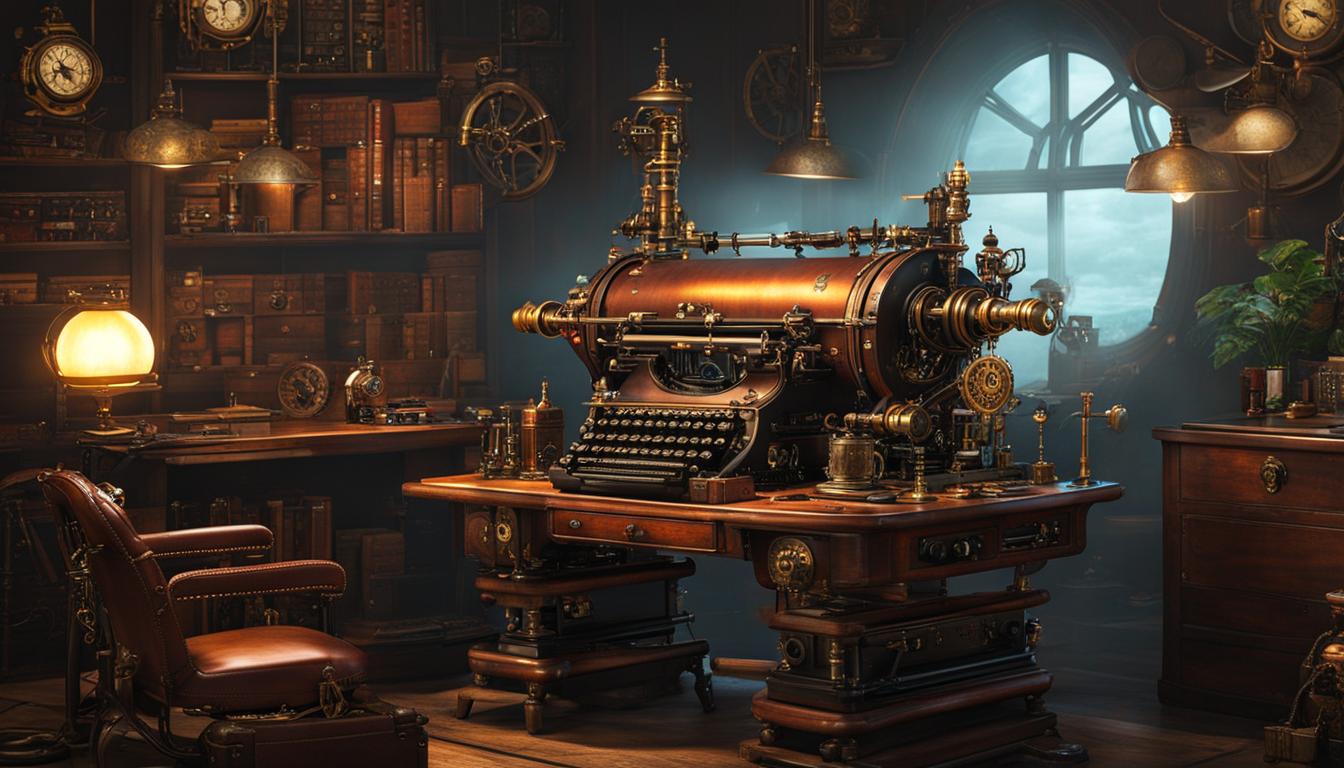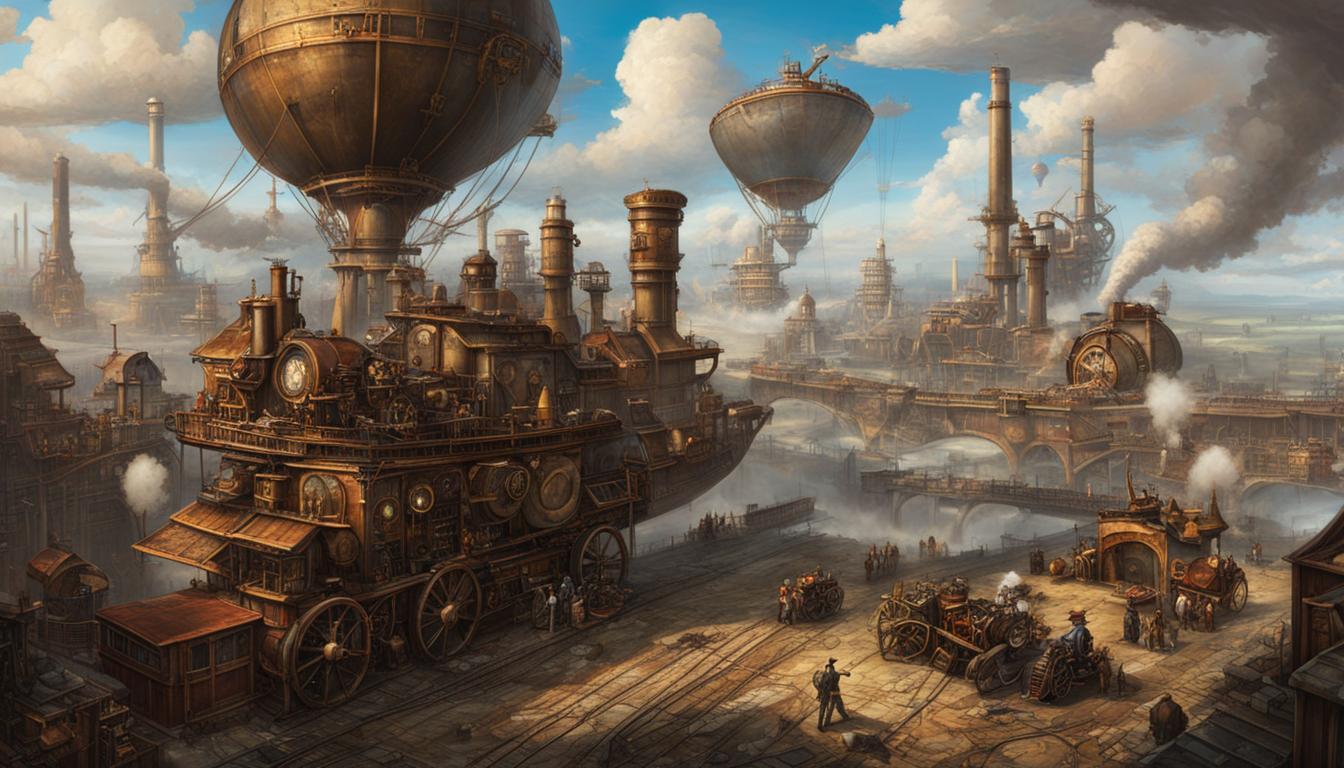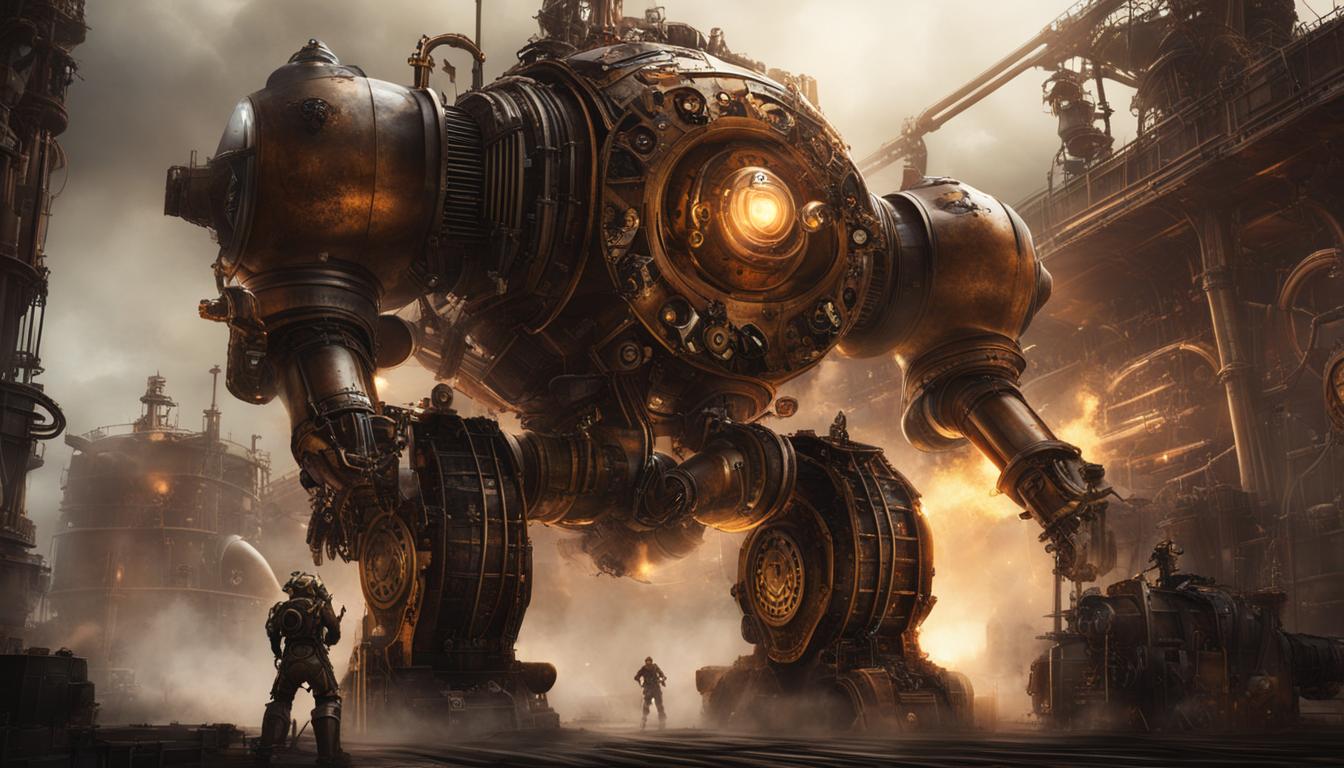Steampunk, the enigmatic genre that combines 19th-century industrial machinery, Victorian-era fashion, and fantastical twists, has captivated the world of game design. Its unique aesthetic and themes have inspired both players and developers, leading to the incorporation of steampunk elements in game creation. From art style and architecture to gameplay mechanics and narrative, steampunk offers a wealth of creative possibilities for game designers to explore.
As game designers embrace the whimsical and imaginative nature of steampunk, they push the boundaries of creativity and imagination. By harnessing the power of steam-powered technology, clockwork mechanisms, and alternate history settings, they create immersive and visually stunning experiences for players.
Key Takeaways:
- Steampunk has a significant influence on game design, inspiring developers to incorporate its unique aesthetic and themes.
- Steampunk’s origins can be traced back to its literary roots, with authors like Jules Verne and H. G. Wells paving the way.
- Game mechanics can incorporate steampunk elements such as steam-powered gadgets, clockwork puzzles, and alternate history settings.
- Steampunk themes in video games explore concepts like society driven by steam technology and the clash between progress and nature.
- Steampunk offers endless creative possibilities for game design, including airship battles, steam-powered combat suits, and intricate clockwork puzzles.
The Origins of Steampunk in Games
The origins of steampunk in games can be traced back to its literary roots. Authors like Jules Verne, H. G. Wells, and K.W. Jeter introduced readers to the world of steam-powered technology and Victorian aesthetics, creating an alternative history where fantastical inventions were the norm. These early pioneers of steampunk literature laid the foundation for the genre’s influence in game design.
“Steampunk is what happens when goths discover brown.”
— Jess Nevins
Games like The Eidolon, Final Fantasy VI, and Thief: The Dark Project embraced the steampunk aesthetic, incorporating elements such as steam-powered machinery, industrial architecture, and a sense of discovery and invention. These games were among the first to fully immerse players in a steampunk world and set the stage for future game designers to explore this unique style.
| Steampunk Pioneers | Key Contributions |
|---|---|
| Jules Verne | Introduced the concept of fantastical steam-powered technology in novels like “20,000 Leagues Under the Sea” and “The Time Machine”. |
| H. G. Wells | Explored futuristic inventions and alternate history settings in works such as “The War of the Worlds” and “The Island of Dr. Moreau”. |
| K.W. Jeter | Coined the term “steampunk” and expanded on the genre with novels like “Infernal Devices” and “Morlock Night”. |
Steampunk in games continues to evolve, with contemporary titles like Dishonored and BioShock Infinite pushing the boundaries of the genre and incorporating new gameplay mechanics and storytelling elements. The influence of steampunk in game design remains strong, captivating players with its unique blend of history, fantasy, and inventive technology.
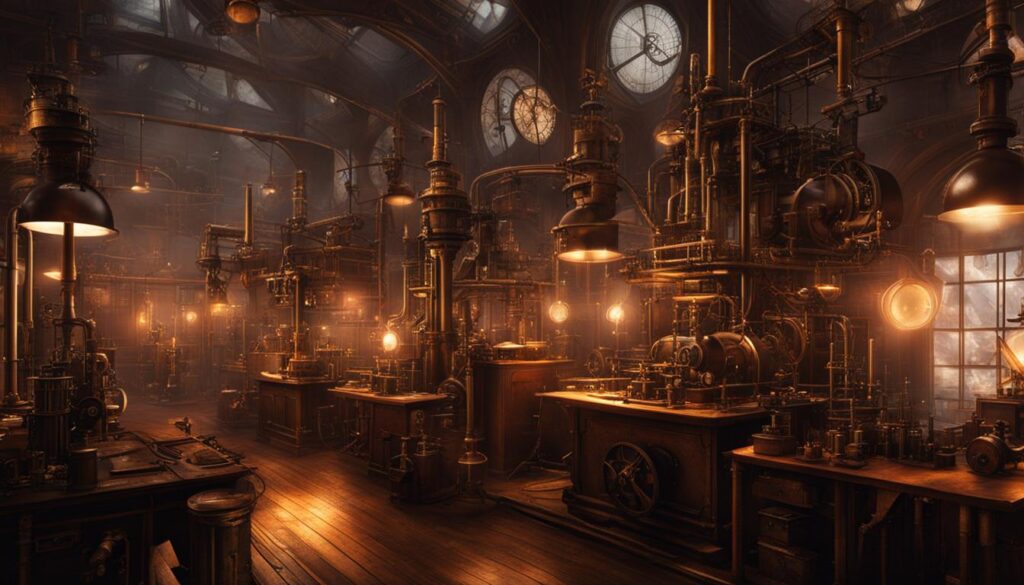
The Steampunk Aesthetic in Literature
Steampunk literature played a crucial role in shaping the aesthetic and themes of steampunk games. The genre’s focus on Victorian fashion, steam power, and industrial machinery laid the foundation for the visual design elements seen in many games today. The influence of steampunk pioneers like Jules Verne, H. G. Wells, and K.W. Jeter can be seen in the intricate details, brass fittings, and clockwork mechanisms that define the steampunk style.
“Steampunk is what happens when goths discover brown.”
— Jess Nevins
Steampunk in Game Mechanics
The incorporation of steampunk elements in game mechanics adds a unique and immersive dimension to gameplay. Designers have skillfully integrated steam-powered gadgets and weapons, clockwork mechanisms, and alternate history settings shaped by steam technology. These elements not only enhance the overall gaming experience but also contribute to the cohesive and engaging nature of steampunk-themed games.
“Steampunk game mechanics offer players a chance to explore the imaginative and whimsical world of steam-powered technology,” says game designer Jane Mitchell. “By incorporating elements like steam-powered grappling hooks, players can navigate intricate levels and access hidden areas, adding depth to the gameplay.”
Moreover, the use of clockwork mechanisms for puzzles and challenges introduces a strategic and problem-solving aspect to the game. Players must analyze and manipulate intricate mechanisms to progress, creating a sense of accomplishment and intellectual engagement.
Additionally, the exploration of alternate history settings where steam technology shapes the game world allows players to immerse themselves in a captivating and dynamic environment. From steam-powered cities to industrial landscapes, these settings provide a visually stunning backdrop for players to navigate and interact with.
Examples of Steampunk Elements in Game Mechanics:
- Steam-powered weapons and gadgets
- Clockwork puzzles and challenges
- Alternate history settings shaped by steam technology
| Game | Genre | Notable Steampunk Elements |
|---|---|---|
| Bioshock Infinite | First-person shooter | Steam-powered weapons, floating city powered by steam |
| Dishonored | Action-adventure | Steam-powered technology, clockwork devices |
| Thief: The Dark Project | Stealth | Industrial architecture, mechanical tools |
By incorporating steampunk elements into game mechanics, designers create a captivating and immersive experience that appeals to players’ curiosity and sense of adventure. The combination of steam-powered technology, clockwork puzzles, and alternate history settings elevates gameplay to a new level, making steampunk-themed games a truly unique and enjoyable experience.
Steampunk Themes in Video Game Design
The integration of steampunk themes in video game design has become increasingly prevalent, adding a distinct atmosphere and narrative direction to games. This unique genre offers game designers the opportunity to explore various concepts and create immersive worlds that captivate players. With its blend of Victorian aesthetics and fantastical technology, steampunk provides a rich palette for game developers to craft visually stunning and engaging experiences.
One prominent theme in steampunk game design is the exploration of a society driven by steam-powered technology. Games set in steam-powered cities or alternate history settings often depict a world where industrial progress clashes with nature, presenting players with a complex and thought-provoking narrative. These games delve into the societal implications of advanced technology and provide players with a chance to navigate the moral and ethical dilemmas that arise in a steampunk world.
Another common steampunk theme in video games is the utilization of steam-powered machinery and gadgets. From steam-powered airships and vehicles to intricate clockwork contraptions, these elements add a sense of wonder and excitement to gameplay. Players are often immersed in the mechanics of steam technology, utilizing steam-powered weapons or solving complex puzzles that require them to manipulate gears and levers.
| Steampunk Themes in Video Game Design | Examples in Games |
|---|---|
| Society driven by steam-powered technology | Cityscapes in Dishonored |
| Clash between industrial progress and nature | The BioShock series |
| Exploration of alternate history settings | Bioshock Infinite |
| Societal implications of advanced technology | Deus Ex: Human Revolution |
| Utilization of steam-powered machinery and gadgets | The Order: 1886 |
Steampunk game design offers a unique blend of history, fantasy, and technology, allowing players to immerse themselves in captivating narratives set in visually stunning worlds.
The integration of steampunk themes in video game design continues to inspire innovation and creativity among game developers. It provides a fertile ground for the exploration of imaginative technologies, the invention of new gadgets, and the examination of society’s response to industrialization. By integrating steampunk elements into their games, developers can create immersive experiences that transport players to an alternate reality filled with wonders and challenges.
As the popularity of steampunk persists, game designers will undoubtedly continue to incorporate its themes and aesthetics into their creations. Whether it’s the exploration of steam-powered cities, the clash between industrial progress and nature, or the utilization of intricate gadgets, steampunk game design offers a unique and captivating experience for players to enjoy.
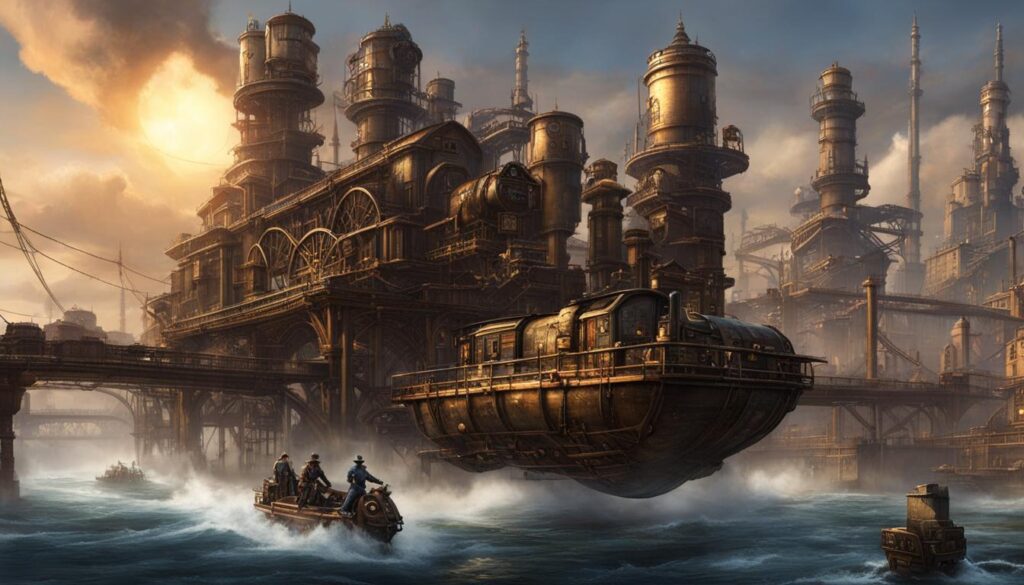
Creative Steampunk Game Design Ideas
When it comes to steampunk game design, the possibilities are as vast as the gears that power the genre’s fantastical machinery. Game designers have been unleashing their creativity to bring unique and innovative concepts to life within the steampunk world. From high-flying airship battles to intricate clockwork puzzles, the realm of steampunk offers a wealth of exciting opportunities to push the boundaries of game design.
“Steampunk game design allows us to combine the allure of Victorian aesthetics with imaginative technology, creating captivating and visually stunning experiences for players,” says renowned game designer Emily Hartman. “One of the most exciting aspects of steampunk is the ability to defy the constraints of reality and offer players something truly extraordinary.”
One captivating idea for a steampunk game is a grand cityscape filled with towering steam-powered buildings and intricate machinery. Players would navigate the bustling streets as they unravel a mysterious conspiracy, encountering eccentric inventors, daring explorers, and cunning villains. This immersive setting would provide endless opportunities for players to interact with the world, uncover hidden secrets, and make meaningful choices that shape the outcome of the story.
| Steampunk Game Design Ideas | Concept | Unique Feature |
|---|---|---|
| Airship Combat | Engage in thrilling battles aboard majestic steam-powered airships. | Real-time strategic combat with modular ship customization. |
| Steam-Powered Combat Suit | Step into the shoes of a daring adventurer equipped with a formidable steam-powered combat suit. | Unique abilities and gadgets that can be upgraded and customized. |
| Intricate Clockwork Puzzles | Challenge players with mind-bending puzzles that rely on intricate clockwork mechanisms. | Progressive difficulty with a mix of logic, pattern recognition, and environmental manipulation. |
| Visually Stunning Steampunk Cityscape | Immerse players in a richly detailed steampunk cityscape with intricate architecture and machinery. | Dynamic day-night cycles and weather effects that affect gameplay and atmosphere. |
These are just a few examples of the creative steampunk game design ideas that have captivated developers and players alike. With the genre’s unique blend of Victorian aesthetics and fantastical technology, the possibilities for innovative gameplay experiences are limitless. Game designers continue to push the boundaries of imagination, crafting worlds where players can explore, invent, and embark on daring adventures within the captivating realm of steampunk.
Steampunk Style in Game Development
The steampunk style has permeated every aspect of game development, leaving its mark on the industry. From concept art and character design to level and environment creation, elements of steampunk can be found throughout the game creation process. Designers strive to capture the essence of Victorian-era fashion, incorporating intricate details, brass, and gears into the game’s art style. This attention to detail not only creates visually stunning games but also helps to transport players into a world of steam-powered technology and industrial aesthetics.
Steampunk style extends beyond the visual design of games. It can also influence gameplay mechanics, narrative choices, and world-building. For example, a game might feature steam-powered gadgets and weapons that add a layer of ingenuity and creativity to combat. Alternatively, developers might explore the societal implications of advanced technology in a steam-powered world, offering players thought-provoking narratives and choices. By embracing the steampunk style in game development, designers can create immersive experiences that transport players to unique and captivating worlds.
In addition to visual and narrative elements, the steampunk style also offers opportunities for creative game mechanics. From clockwork puzzles and intricate machinery to the exploration of alternate history settings where steam technology shapes the game world, the incorporation of steampunk elements elevates the gameplay experience. By integrating these thematic and mechanical elements into game design, developers can create innovative and engaging experiences that captivate players.
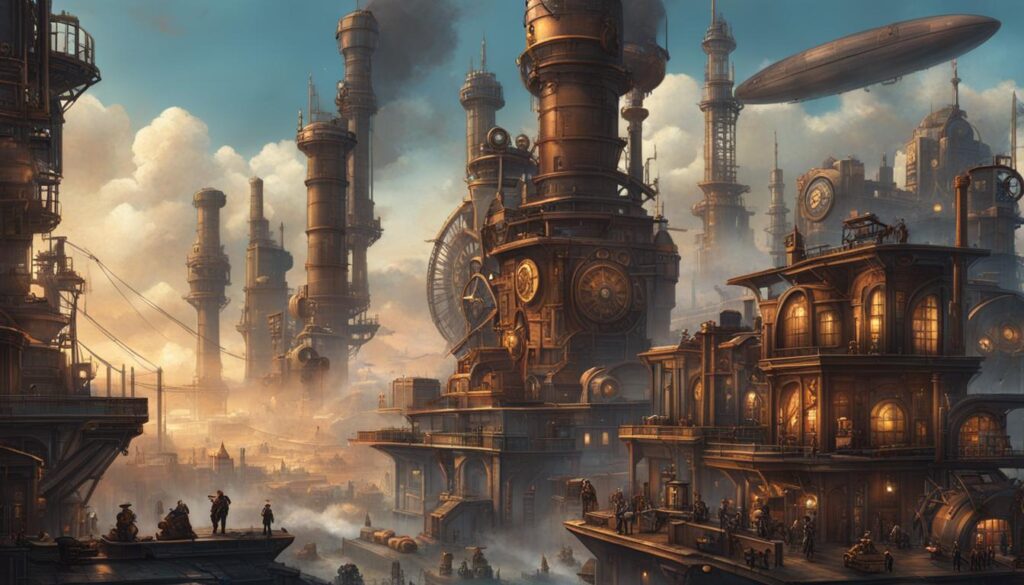
The Influence of Steampunk Architecture in Game Design
“Steampunk architecture provides a sense of grandeur and mechanical wonder, with its towering structures adorned with gears, pipes, and intricate details,” explains game designer Jane Davis. “It offers a unique visual appeal and can contribute to the overall immersive experience of a game.”
The architectural elements of steampunk, such as elaborate clock towers, sprawling factories, and ornate airship docks, enhance the sense of wonder and adventure in game worlds. By incorporating these architectural styles, game designers can create visually striking environments that transport players to a world of steam-powered technology and Victorian aesthetics.
Furthermore, the integration of steampunk architecture can also affect gameplay mechanics. For example, players may need to navigate complex machinery and mechanical puzzles within the structures, adding an extra layer of challenge and exploration. The architectural choices made in game design can also contribute to the overall narrative and storytelling, reinforcing the steampunk themes and immersing players in a rich and vibrant world.
| Steampunk Architecture in Games | Examples |
|---|---|
| Elaborate clock towers | Bioshock Infinite |
| Sprawling factories | Dishonored |
| Ornate airship docks | Final Fantasy XII |
The table above showcases examples of how steampunk architecture has been integrated into various games. Each of these games utilizes the distinct visual and thematic elements of steampunk to create memorable and immersive experiences for players. By incorporating steampunk architecture into game design, developers can tap into the sense of wonder and adventure that the style evokes, enhancing the overall gameplay experience.
Conclusion
As the curtains draw to a close, it is undeniable that the influence of steampunk in game design has left an indelible mark on the gaming landscape. From its origins in literature to its integration into game mechanics, themes, and art styles, steampunk has captivated both players and developers with its unique blend of aesthetics and imagination.
The incorporation of steampunk elements in game design has allowed for the creation of visually stunning and immersive experiences. From the intricate clockwork puzzles to the steam-powered gadgets and airship battles, steampunk offers endless creative possibilities for game designers to explore and push the boundaries of innovation.
By embracing the whimsical and mysterious nature of steampunk, game developers have created captivating worlds where players can delve into intriguing narratives and engage with the steampunk aesthetic. The clash between industrial progress and nature, the exploration of alternate history settings, and the societal implications of advanced technology are just some of the thought-provoking themes that have been explored through the lens of steampunk.
As we bid farewell to this remarkable journey, it is clear that steampunk will continue to inspire future generations of game designers. Its influence will be felt in the creation of visually stunning and immersive experiences that transport players to fantastical worlds where steam-powered machinery and Victorian-era fashion coexist. Steampunk has forever enriched the world of game design, leaving us eagerly anticipating the next chapter in this enduring saga.
FAQ
What is the influence of steampunk in game design?
Steampunk has had a significant influence on game design, inspiring developers to create visually stunning and immersive experiences for players.
Where did steampunk originate in games?
Steampunk originated in literature, with authors like Jules Verne and H. G. Wells introducing readers to a world of steam-powered technology and Victorian aesthetics.
How does steampunk influence game mechanics?
Steampunk elements are integrated into gameplay mechanics, featuring steam-powered gadgets, clockwork puzzles, and alternate history settings shaped by steam technology.
What themes does steampunk explore in video game design?
Steampunk themes in games include societies driven by steam-powered technology, the clash between progress and nature, and the societal implications of advanced technology.
What are some creative steampunk game design ideas?
Creative steampunk game design ideas can include airship battles, steam-powered combat suits, intricate clockwork puzzles, and visually stunning steampunk cityscapes.
How is the steampunk style incorporated in game development?
The steampunk style is incorporated in game development through visual aesthetics, architecture, technology, and fashion inspired by the Victorian era.
What is the overall influence of steampunk in game design?
Steampunk has made a significant impact on game design, inspiring developers to create unique and memorable games that push the boundaries of creativity and imagination.

